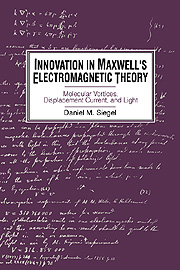Book contents
- Frontmatter
- Contents
- Preface
- Introduction
- 1 The background to Maxwell's electromagnetic theory
- 2 Mechanical image and reality in Maxwell's electromagnetic theory
- 3 The elaboration of the molecular-vortex model
- 4 The introduction of the displacement current
- 5 The origin of the electromagnetic theory of light
- 6 Beyond molecular vortices
- Conclusion
- Appendix 1 Draft of “On Physical Lines of Force,” a fragment
- Appendix 2 Drafts of “A Dynamical Theory of the Electromagnetic Field”
- Appendix 3 Vortex rotations in a curl-free region
- Notes
- Index
4 - The introduction of the displacement current
Published online by Cambridge University Press: 24 October 2009
- Frontmatter
- Contents
- Preface
- Introduction
- 1 The background to Maxwell's electromagnetic theory
- 2 Mechanical image and reality in Maxwell's electromagnetic theory
- 3 The elaboration of the molecular-vortex model
- 4 The introduction of the displacement current
- 5 The origin of the electromagnetic theory of light
- 6 Beyond molecular vortices
- Conclusion
- Appendix 1 Draft of “On Physical Lines of Force,” a fragment
- Appendix 2 Drafts of “A Dynamical Theory of the Electromagnetic Field”
- Appendix 3 Vortex rotations in a curl-free region
- Notes
- Index
Summary
The immediate context for Maxwell's initial modification of Ampère's law (Ampère's circuital law in differential form), through the introduction of a new term to be known as the “displacement current,” was, as we have seen, his work on the theory of molecular vortices: His proximate aim in modifying Ampère's law was to extend the theory of molecular vortices to electrostatics, and his explicit interpretation at that point of the modified equation was as a mechanical calculation in the theory of molecular vortices, with the new term expressing the flux of the small idle-wheel particles owing to progressive elastic deformation of the vortices. All of the principal symbols and equations in “Physical Lines,” however, had dual significance – mechanical and electromagnetic – and the modified Ampère's law, in its electromagnetic character, had broader connections and significance, transcending its proximate matrix in the theory of molecular vortices. That broader context must be taken into account if we are to achieve a full understanding of the origin of the displacement current and its significance in the history of electromagnetic theory.
The question of the origin of the displacement current has been, and continues to be, the object of much interest and concern: Each year many thousands of students in physics courses throughout the world learn that Maxwell, on the basis of theoretical considerations, modified Ampère's law, through the introduction of a new term called the displacement current, and thereby perfected the enduring foundation for modern electromagnetic theory.
- Type
- Chapter
- Information
- Innovation in Maxwell's Electromagnetic TheoryMolecular Vortices, Displacement Current, and Light, pp. 85 - 119Publisher: Cambridge University PressPrint publication year: 1992



